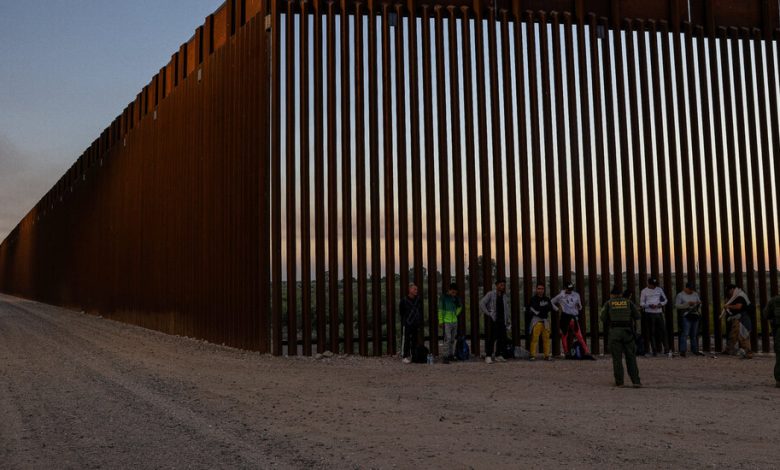Border Wall Falls Leave Migrants With Devastating — and Costly — Injuries

Ambulances rush them daily to hospitals in El Paso, San Diego and Tucson, Ariz., writhing in pain — bones poking out of arms and legs; skulls cracked; spines shattered. The men and women arrive on stretchers flanked by an agent in the telltale green uniform of the U.S. Border Patrol.
“One look, and I know it’s another wall fall,” said Brian Elmore, an emergency medicine physician at Texas Tech University Health Sciences Center in El Paso.
The patients are all migrants who have crashed to the ground while trying to climb over the wall that separates Mexico and the United States for long stretches of the border.
In a quest to stop unauthorized immigration, the U.S. government has in recent years extended the length and height of the fortifications, and a new stretch has been authorized by the Biden administration. But many migrants have been undaunted by the barriers, and for hundreds of them, the result has been debilitating injuries that require multiple surgeries, according to physicians working in U.S. hospitals near the border.
President Donald J. Trump, who made “the wall” central to his immigration agenda, ordered construction in California of a double-layered, 30-foot-tall steel bollard barrier to replace more than 400 miles of fencing that ranged from eight feet to 17 feet in height.
Since the project was completed in 2019, the number of wall-fall patients admitted to the trauma center at U.C. San Diego Health trauma center has increased sevenfold, to 311 in 2022. This year, that number is expected to surpass 350, according to the hospital, which said the number of deaths from falls has gone from zero between 2016 and 2019 to 23 since then.
A comprehensive accounting of wall-related injuries and deaths does not exist, but physicians along the border have been stepping up efforts to track and study fall-related injuries and deaths. They say that the increase in recent years is significant even given the increase in border apprehensions, and that the influx of severely injured patients is straining U.S. hospitals along the border.
Caring for the patients can impose a sizable financial burden because the migrants typically lack insurance yet often require multiple complex surgeries and extended inpatient care.
“The problem is getting worse and worse,” said Dr. Jay Doucet, chief of the trauma unit at U.C. San Diego Health, which is about 15 miles from the Tijuana-San Ysidro border crossing, “and the hospital system is taking a big hit.”
The cost of caring for migrants at San Diego’s two trauma centers — U.C. San Diego Health and Scripps Mercy Hospital — has increased from $11 million between 2016 and 2019 to $72 million from 2020 to June 2022, the latest number available.
The current network of barriers dates to the 1990s, begun under President Bill Clinton, and every administration since has erected barriers, with President Trump making “the wall” central to his immigration agenda.
President Biden, who defeated Mr. Trump in 2020, had derided Mr. Trump’s intense focus on the wall. Nevertheless, Mr. Biden recently authorized an expansion of barriers in South Texas, saying his administration could not block the use of millions of dollars appropriated by Congress in 2019 for wall construction. But Mr. Biden has also been under pressure to take a harder line on unlawful immigration, which has stretched government resources and fueled criticism of the president ahead of the 2024 election.
Mr. Trump, the front-runner for the Republican presidential nomination, and aides who worked with him when he was in the White House have been mapping out a plan to revive many of his administration’s anti-immigration efforts and in some cases to take even more aggressive approaches.
Agents made more than 2.4 million apprehensions in the fiscal year that ended Sept. 30, a record, at a time when more people than ever around the globe were fleeing their homelands for a confluence of reasons, such as political upheaval, economic duress and extreme weather.
Asked to comment on wall falls and their effect on border hospitals, U.S. Customs and Border Protection said in a statement: “CBP’s message for anyone who is thinking of entering the United States illegally along the Southern border is simple: Don’t do it. When migrants cross the border illegally, they put their lives in peril.”
Adam Hosein, an associate professor of philosophy at Northeastern University who studies the ethics of border policy, said that migrants who had crossed deserts and jungles to flee depravation were acting under “extreme duress” by the time they reached the doorstep of the United States.
“These are people willing to risk everything to get here,” said Mr. Hosein, author of a book about the ethics of migration. “The wall is having little or no effect while causing extreme harm, for which the United States bears responsibility.”
RosmarieCepeda, 40, arrived in Ciudad Juárez, Mexico, in early May after a monthslong journey from Venezuela. She said she tried using the U.S. government’s mobile app to make an appointment to enter El Paso through an official port of entry. But demand for the slots is intense and she wasn’t able to secure one, so she decided to take her chances.
“I had no choice but to climb the wall,” she said. “I have three children in Venezuela to support.”
On her way down in the darkness, Ms. Cepeda plummeted to the ground, shattering her lower left leg and foot. She was taken to a hospital in El Paso and underwent multiple surgeries to realign and fix her bones. She was in a wheelchair for months.
Alexander Tenorio, a neurosurgeon at U.C. San Diego, has operated on migrants with scalp lacerations that tore through to the skull. Others suffered brain damage that permanently impaired their ability to talk, walk and care for themselves. Many needed intubation for breathing, had to undergo multiple surgeries and remained for months in the hospital.
Last year, U.C. San Diego had to convert a postpartum unit into a ward for the border-wall casualties. Treating gravely injured migrants has affected care for the local population. For instance, the wait time for spinal procedures has increased to nearly two weeks from three days.
“This is at our center alone, and we only see severe trauma,” said Dr. Tenorio, who testified before Congress in July and has co-authored three papers on traumatic neurological injuries associated with the raised height of the wall.
“It’s an untold, heartbreaking story of unnecessary human suffering,” he said.
Smugglers often affix makeshift ladders to the wall on the Mexican side, which they hold in place as migrants climb to the top. It is on the descent, clinging only to the slats on the other side, often at night, that migrants sometimes slip or let go too soon, and plunge from dangerous heights onto U.S. soil.
Along the El Paso sector, a 260-mile span of the border where barriers range in height from 18 feet to 30 feet, lower-extremity fractures are the most common, and they often result in several broken bones that require more than one surgery.
“In the general population you see these injuries after car or motorcycle accidents, but nothing like with the frequency you see here,” said Rajiv Rajani, chair of orthopedic surgery and rehabilitation at Texas Tech University Health Sciences Center El Paso and co-author of a recent study about border falls.
Because most migrants do not receive follow-up care, such as physical therapy or X-rays, which is vital to achieve full recovery, he said, the injuries are often “life altering.”
Erwin Gomez, 26, another Venezuelan migrant, crushed his left forearm when he lost his grip sliding down the wall near El Paso last spring.
Border Patrol agents transported him to Texas Tech Health, where he underwent two surgeries. Plates and screws were inserted in his forearm to stabilize the bones and allow them to heal; the skin was stapled together.
Five months later, from Dallas, Mr. Gomez said that he had removed the staples on his own and had not been able to get prescribed physical therapy.
“I can’t work because I can’t lift anything heavy,” said Mr. Gomez, who was a sergeant in the Venezuelan army. “But without a job, I can’t afford any treatment.”
Sheelagh McNeill contributed research.



